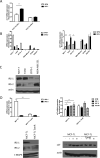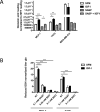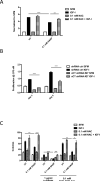IGF-I regulates redox status in breast cancer cells by activating the amino acid transport molecule xC-
- PMID: 24686172
- PMCID: PMC4006361
- DOI: 10.1158/0008-5472.CAN-13-1803
IGF-I regulates redox status in breast cancer cells by activating the amino acid transport molecule xC-
Abstract
Insulin-like growth factors (IGF) stimulate cell growth in part by increasing amino acid uptake. xCT (SLC7A11) encodes the functional subunit of the cell surface transport system xC(-), which mediates cystine uptake, a pivotal step in glutathione synthesis and cellular redox control. In this study, we show that IGF-I regulates cystine uptake and cellular redox status by activating the expression and function of xCT in estrogen receptor-positive (ER(+)) breast cancer cells by a mechanism that relies on the IGF receptor substrate-1 (IRS-1). Breast cancer cell proliferation mediated by IGF-I was suppressed by attenuating xCT expression or blocking xCT activity with the pharmacologic inhibitor sulfasalazine (SASP). Notably, SASP sensitized breast cancer cells to inhibitors of the type I IGF receptor (IGF-IR) in a manner reversed by the reactive oxygen species (ROS) scavenger N-acetyl-L-cysteine. Thus, IGF-I promoted the proliferation of ER(+) breast cancer cells by regulating xC(-) transporter function to protect cancer cells from ROS in an IRS-1-dependent manner. Our findings suggest that inhibiting xC(-) transporter function may synergize with modalities that target the IGF-IR to heighten their therapeutic effects.
©2014 AACR.
Figures






Similar articles
-
Signal transducer and activator of transcription 3 and 5 regulate system Xc- and redox balance in human breast cancer cells.Mol Cell Biochem. 2015 Jul;405(1-2):205-21. doi: 10.1007/s11010-015-2412-4. Epub 2015 Apr 21. Mol Cell Biochem. 2015. PMID: 25896132
-
Expression of xCT and activity of system xc(-) are regulated by NRF2 in human breast cancer cells in response to oxidative stress.Redox Biol. 2015 Aug;5:33-42. doi: 10.1016/j.redox.2015.03.003. Epub 2015 Mar 18. Redox Biol. 2015. PMID: 25827424 Free PMC article.
-
Non-invasive Use of Positron Emission Tomography to Monitor Diethyl maleate and Radiation-Induced Changes in System xC- Activity in Breast Cancer.Mol Imaging Biol. 2019 Dec;21(6):1107-1116. doi: 10.1007/s11307-019-01331-8. Mol Imaging Biol. 2019. PMID: 30838549
-
Cystine-glutamate antiporter xCT as a therapeutic target for cancer.Cell Biochem Funct. 2021 Mar;39(2):174-179. doi: 10.1002/cbf.3581. Epub 2020 Aug 4. Cell Biochem Funct. 2021. PMID: 32749001 Review.
-
xCT: A Critical Molecule That Links Cancer Metabolism to Redox Signaling.Mol Ther. 2020 Nov 4;28(11):2358-2366. doi: 10.1016/j.ymthe.2020.08.021. Epub 2020 Sep 2. Mol Ther. 2020. PMID: 32931751 Free PMC article. Review.
Cited by
-
Research progress on SLC7A11 in the regulation of cystine/cysteine metabolism in tumors.Oncol Lett. 2022 Feb;23(2):47. doi: 10.3892/ol.2021.13165. Epub 2021 Dec 14. Oncol Lett. 2022. PMID: 34992680 Free PMC article. Review.
-
Amino Acid Transporters and Glutamine Metabolism in Breast Cancer.Int J Mol Sci. 2018 Mar 19;19(3):907. doi: 10.3390/ijms19030907. Int J Mol Sci. 2018. PMID: 29562706 Free PMC article. Review.
-
The role of glutamate receptors in the regulation of the tumor microenvironment.Front Immunol. 2023 Feb 1;14:1123841. doi: 10.3389/fimmu.2023.1123841. eCollection 2023. Front Immunol. 2023. PMID: 36817470 Free PMC article.
-
Eye on the horizon: The metabolic landscape of the RPE in aging and disease.Prog Retin Eye Res. 2025 Jan;104:101306. doi: 10.1016/j.preteyeres.2024.101306. Epub 2024 Oct 19. Prog Retin Eye Res. 2025. PMID: 39433211 Free PMC article. Review.
-
xCT inhibition sensitizes tumors to γ-radiation via glutathione reduction.Oncotarget. 2018 Aug 17;9(64):32280-32297. doi: 10.18632/oncotarget.25794. eCollection 2018 Aug 17. Oncotarget. 2018. PMID: 30190786 Free PMC article.
References
-
- Sachdev D, Yee D. The IGF system and breast cancer. Endocr Relat Cancer. 2001;8:197–209. - PubMed
-
- Pollak M. The insulin and insulin-like growth factor receptor family in neoplasia: an update. Nat Rev Cancer. 2012;12:159–69. - PubMed
-
- Taniguchi CM, Emanuelli B, Kahn CR. Critical nodes in signalling pathways: insights into insulin action. Nature reviews Molecular cell biology. 2006;7:85–96. - PubMed
-
- Jackson JG, White MF, Yee D. Insulin receptor substrate-1 is the predominant signaling molecule activated by insulin-like growth factor-I, insulin, and interleukin-4 in estrogen receptor-positive human breast cancer cells. J Biol Chem. 1998;273:9994–10003. - PubMed
Publication types
MeSH terms
Substances
Grants and funding
LinkOut - more resources
Full Text Sources
Other Literature Sources
Medical

